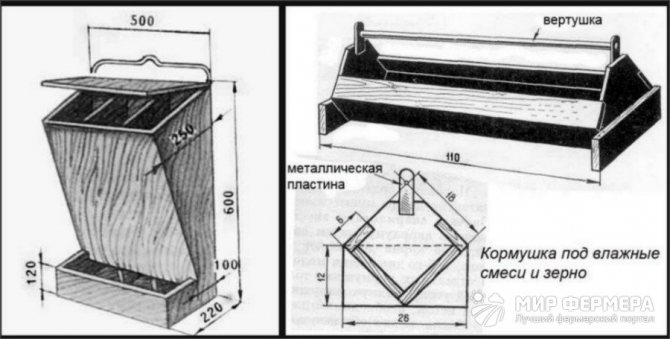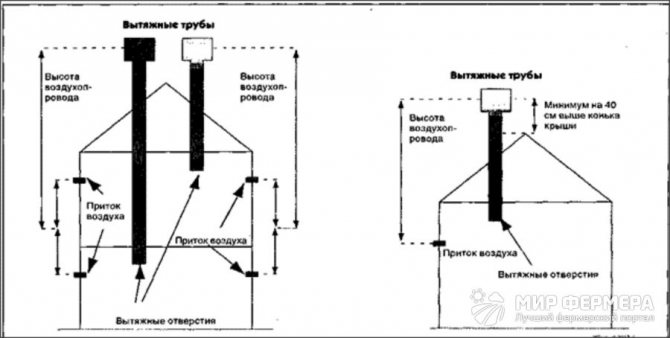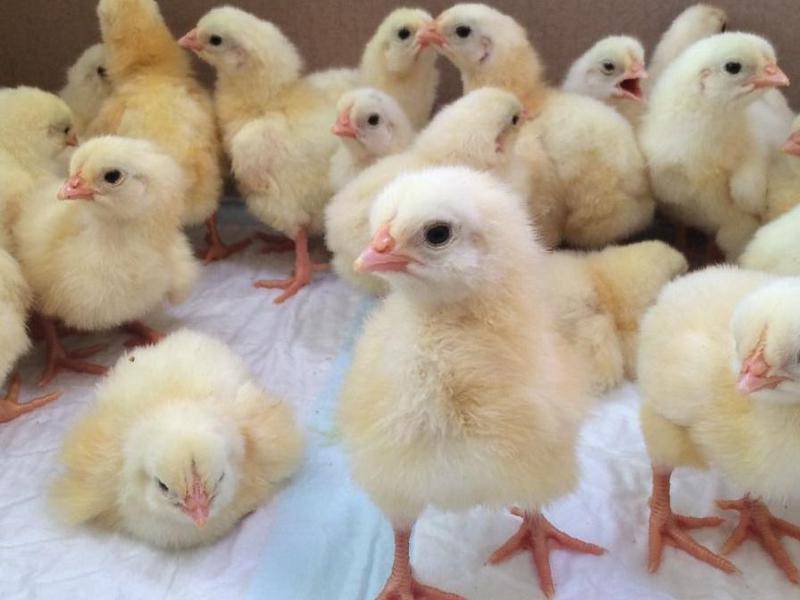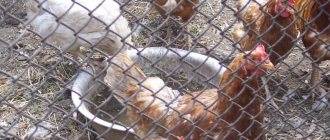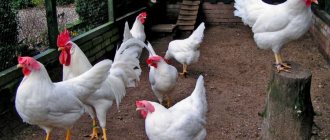Keeping chickens at home: grooming tips for beginners

It is not so difficult to organize poultry farming at home, the main thing is to properly equip a room for birds, and take care of a full-fledged diet.
Let's start with the premises:
- Compliance with the temperature regime. The optimum temperature is 23-25 ° C. In such conditions, there will be good egg production. In winter, the temperature should not be lower than 15 ° C heat.
- Ventilation. The room should have vents, but it is better to equip an exhaust hood with plugs for such purposes.
- Flooring. Mostly made of wood or adobe. Cover the floor with a litter of sawdust, straw, hay, etc. In winter, the litter is compacted to save heat.
- Accommodation. For every 5 chickens, there should be 1 square meter. m.
- Lighting. Additional lighting will be needed to obtain high egg production while reducing daylight hours. The day is lengthened only after molting.
- Perches. Should be located a maximum of 1.2 meters from the floor near the window. One individual has about 20 centimeters of perch. The distance between the crossbars is maintained at 50 centimeters.
- Nests. Set up in the darkened corners of the chicken coop. One nest is enough for 5-6 individuals. For convenience, use wooden boxes, fill them with shavings, straw, hay.
- Laz. In addition to the main door to the chicken coop, an additional manhole is made so that the chickens can freely go out to the walking yard.


Feeders. One individual should have 10-15 centimeters of the feeder. It is recommended to place them above the floor, at a low height. Chickens will not rake feed.- Drinking bowls. The best option is 5-6 liters. In the summer, the water is changed often enough to avoid attenuation.
- Ash containers. Chickens are attacked by various parasites. Ash trays will prevent them from appearing. In addition, chickens enjoy such bathing.
The concrete floor is contraindicated, it is cold and increases the dampness in the room.
Hinged lifting perches will make cleaning indoors easier.
For full development and good egg production, chickens should be provided with proper nutrition:
- Cereals. Grain contains little protein and should be mixed with protein feed. In summer, it is recommended to give oats, millet, barley - they improve egg production. In winter, for weight gain and energy conservation - wheat, corn and buckwheat. A good protein supplement is cake and meal, beans.
- Green food. Contains many vitamins and minerals. It is supposed to give no more than 20% of greens per day, since most of the birds are eaten while walking. With free-range maintenance, dill, clover, young peas, and alfalfa are introduced into the diet. Nettle is considered the most valuable.
- Roots. It is recommended to add carrots and beets, pumpkin and turnips, potatoes to the diet. Vegetables are boiled and added to wet mash. You can also put waste from the table in them.
- Animal feed. Dairy products provide chicks for full development. Good supplements include earthworms, crushed bones, fish and meat and bone meal.
ATTENTION! Chickens must be given mineral supplements: ash, gravel, chalk, shell rock.
Feeding hens


The best egg production results can only be achieved when laying hens have an established daily routine.
Optimal scheme for feeding birds:
- Chickens should get up very early. At the same time, they should not be given breakfast right away, first you need to let them go for a walk.
- The first meal of the day should be around 9 o'clock. Calculate the amount of food so that hens can eat it for 30-40 minutes. After this time, all feeders should be empty. If there is grain left in them, cut the morning portion the next day, and remove the remaining feed to avoid spoilage.
- The daily portion is served at 15:00. After an hour and a half after lunch, wash the feeders of food debris and collect the droppings from the litter.
- Birds should be fed supper one hour before bedtime. At 21:00 you need to turn off the lights and drive the hens to perch.
In order to increase the number of laid eggs, dry food should be given to the chickens in the morning and in the evening, and wet food at lunchtime.
The daily diet of chickens should approximately fit into this framework:
- 50 grams of grain;
- 2 grams of bone meal;
- 30 grams of wet food;
- 40 grams of flour mixture;
- 15 grams of vitamins and mineral supplements.
Chicks in their first year of life are advised to be given more protein food to help them grow and gain weight. Avoid the sticky consistency of the food, it can clog the intestines, the food should be crumbly.
DIY bird cage


You can build a chicken cage at home as follows:
- We make a frame. Mostly they use a metal corner, but wood is also suitable.
- For construction, you will need vertical posts - 4 pieces, long beams - 6 pieces, short beams - 6 pieces.
- The crossbars are connected to each other - the frame is ready. For stability, you can add a pair of uprights in the middle.
- The compartment is about 60 centimeters high, 2 meters wide, and about 65 centimeters deep.
- The bottom is made of strong mesh, a slight slope is made so that the eggs roll into the egg collector.
- The roof and back wall are made of plywood.
- The side walls are installed on hinges, latches are added - the door is ready.
- Feeders and drinkers are attached outside.
Layers
The size of the cage is directly related to the size of the chicken. To make the stay comfortable, one hen should have about 0.2 sq. m, stocking density - 5-6 heads.
When caged, laying hens will need artificial lighting for good egg production. It should be distributed evenly throughout the cage room. Strongly bright light is prohibited so that the bird does not have stress. Initially, the light period lasts 13 hours, then it can be extended to 17 hours. The increase is done gradually.
Laying hens ration with cage keeping:
- wheat;
- sunflower cake;
- calcium carbonate;
- vegetable fats;
- vitamins and minerals, salt.
Broilers
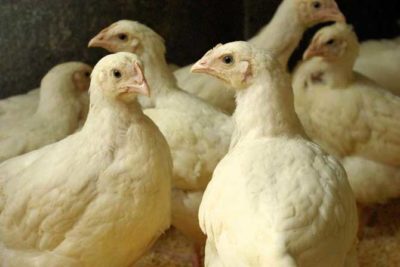

The stocking density of a broiler in a cage should be 1 sq. m for 10 heads. For such care, it is better to give preference to cellular batteries.
Mostly broilers are raised for meat. In pursuit of this goal, the light regime lasts around the clock for 3 weeks. By the end of the cultivation, it can be reduced to 17 hours.
Broiler diet with cage keeping:
- crushed and whole grains;
- cellulose;
- fats;
- calcium;
- vitamin complex.
Grain should make up approximately 65% of the total feed. To gain weight, the bird is provided with free access to the feeders around the clock.
IMPORTANT! With the cage keeping of both laying hens and broilers, cleaning is carried out every 2-3 days, feeders and drinkers are washed daily.
Equipment Needed - Perches and Nests
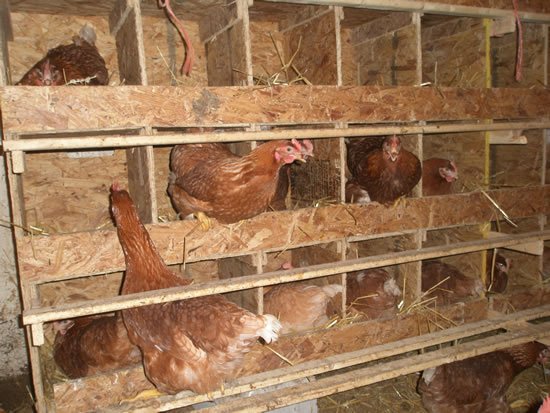

Roosts are usually set up for small chickens. Such devices are necessary for birds - chickens sleep on them at night and can rest during the day. The types of perches can be different:
- if there are few chickens on the farm, then the optimal roost will be a crossbar located along the perimeter of the chicken coop, attached at a short distance from the wall;
- you can arrange such crossbeams at different distances of arcs relative to each other (at a distance of at least 0.3 m). In this case, the birds, settling down for the night, will not stain each other with droppings;
- it is fashionable to dig in vertical supports up to 1-1.2 m high, on which the crossbeams are attached;
- in relatively large poultry houses, perches are fixed on a long table. Vertical supports are attached to it, onto which the crossbars are screwed. And on the table there are boxes for collecting droppings.
Nests in which chickens will lay eggs can be boxes with openings inside which the bird will feel safe and calmly lay eggs. As temporary nests, you can use improvised means - boxes, baskets or boxes. But it is best to equip nests with egg collectors. In this case, the floor in the nest should be inclined, or there may be a funnel-shaped hole in the bottom of it, into which the laid egg rolls.
The number of nests to be built depends on the number of layers on the farm: for every three layers, a separate nest with dimensions of 30 by 40 cm and a depth of up to 40-50 cm should be arranged.
Chicken coop
When building a chicken coop, certain rules should be followed:
- place the room on a hill so that it remains dry and warm;
- the area is chosen to be quiet, calm, in a noisy environment, the productivity of laying hens decreases;
- there should be no road nearby;
- no closer than 3 meters from a residential building.
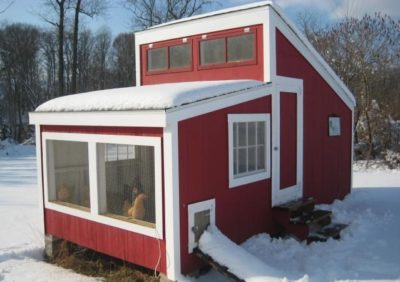

A vestibule is required in the chicken coop. During the winter, the amount of cold that the farmer will enter will be much less.
The poultry house is built per 1 sq. m - 4 chickens of an egg breed or 3 chickens of meat and eggs. For example, a chicken coop for 50 birds should average 15 square meters. m. The nests are arranged near a wall 6 meters long.
For construction, you can use foam blocks, bricks, wood, shell rock. The chicken coop is equipped with nests, perches, drinkers and feeders, an ash container, ventilation, lighting, heaters. It is recommended to insulate the building itself so that the chickens feel comfortable in winter.
Disinfection
It will not be possible to grow a productive and healthy livestock without observing sanitary rules in the chicken coop. Cleaning and disinfection are carried out as follows:
- They sweep the ceilings, walls, clean the perches.
- Change the floor mat.
- If the content is cellular, the metal surface is burned with a blowtorch.
- Surfaces of stone and concrete are treated with lime (copper sulfate can be added to it to prevent the development of fungal infections).
- The entire chicken coop is sprayed with a disinfectant solution, according to the instructions.
- The room is ventilated.
- Drinkers and feeders are washed out.
Ventilation
Special attention should be paid to ventilation. Bird droppings contain harmful ammonia vapors, so access to fresh air is vital for birds.
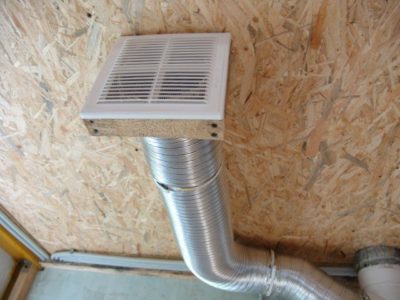

Ventilation can be done in several ways:
- Window equipment, but in no case should a draft be created. The optimal place for a window is under the door.
- A couple of holes are made on the roof, a large pipe goes into one, and a smaller pipe into the second. This option is more suitable for the winter period.
- Ventilation system installation. This method is more common in poultry farms.
Content types
There are several types of bird keeping. Each of them has certain features.
See also
How many days or days does it take for a hen to hatch chicks, recommendations for the selection of eggsRead
Cellular (walk-free)
This type of chicken breeding is usually used for meat breeds. It greatly simplifies bird care. Domestic chickens need free space.This is especially true for hens. Egg production depends on their mobility.
Birds that need to gain weight quickly are kept in cages. This method has undeniable advantages:
- there is no need to worry about the safety of individuals;
- cells are easy to wash and clean;
- it is possible to make the dispensing of water and feed automatic;
- it is easy to increase the number of livestock;
- the risk of infection of chickens is minimized.
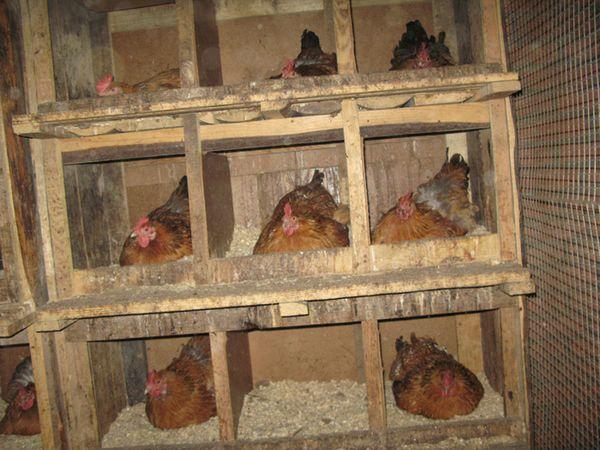

Reduced physical activity in beef breeds, combined with a properly formulated diet, ensures rapid weight gain. This content is used when growing broilers.
Walking
This method does not mean that the birds are constantly in the open area. In such a situation, a closed chicken coop and an open-air cage are made. In winter, the room must be heated. The aviary is complemented with a high fence so that the birds do not scatter. The ratio of the area of the chicken coop to the pen is 1: 4.
The walking method is characterized by the following features:
- the quality of eggs increases and their number increases;
- the bird is free;
- the cost of feed and electricity is reduced;
- chickens are less sick and retain reproductive capabilities for a long time.
On mesh (slat) floors
This option allows you to place more individuals than in a regular cage. On 1 square meter it is worth keeping up to 10-12 chickens. This is ensured by the self-cleaning of the house.
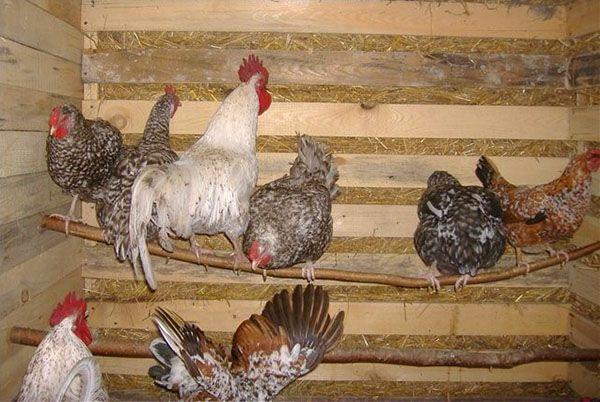

It is recommended to use metal mesh instead of the floor. A wooden lattice is also perfect. This allows the faeces to fall through the cells and onto a removable tray or concrete floor.
The feeders are installed from the outside. Thanks to this, the chickens do not trample or carry food. This makes it possible to save 15% of the feed.
Deep litter
Keeping chickens with this method is irrational, but it remains popular with many poultry farmers. To implement this method, it is recommended to build cells. Litter is poured onto the floor of the chicken coop. It includes a thick layer of straw or wood shavings. Biochemical processes help to heat the litter up to +35 degrees. This saves on electricity costs.
Before using deep bedding, it is worth tamping down the dirt floor well. Then it is covered with a layer of lime. For 1 square meter of the floor, 1 kilogram of the substance is used. The litter should be at least 15 centimeters thick.
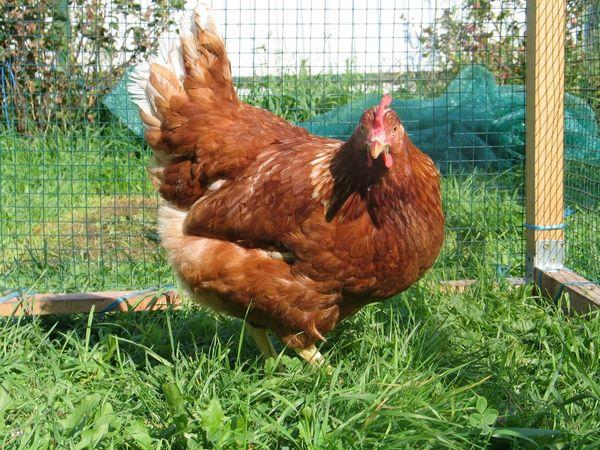

The disadvantages of this technique include egg contamination, ineffective use of the premises, and the risk of disease. A maximum of 5 birds can be accommodated on 1 square meter of the chicken coop.
Walking
For the correct organization of walking, you must adhere to the following recommendations:
- When keeping chickens in the hen house, walking is organized. Usually the aviary is erected on the south side.
- For this, the territory is fenced off with a net (for example, a chain-link).
- For layers, the height is 2 meters, for meat breeds, 1.8 meters are enough.
- Drinking bowls and feeders, a container with fine gravel are placed in the walking yard.
ATTENTION! In the open air, feed quickly deteriorates, especially wet mash. Feeders should be washed immediately after the chickens are full.
The productivity of chickens in the open air increases, they rush more often, the meat is of high quality.
Also, walking can be free. Chickens go for a walk whenever they want, and also come back. This method allows the farmer to save on feed, but the vegetable garden will be at risk.
How to choose young animals?
First, the young for the production of eggs are selected from the breeds of the egg direction. It is naive to hope for a high egg production of chickens in another direction, for example, meat.


Breeds of laying hens
You can choose young from the following breeds: Russian white, Andalusian, Leghorn, Czech golden, May Day, Italian partridge, Minorki, Carpathian greenlegs, Hamburg, Loman Brown, Hisex, Kuchin jubilee others.As a result of selection, new cross-chickens are bred: Borki-1,2, Irtysh, Zaslavsky-1,2,3, Zarya-17, Gibro-6 and many others.
If you have already decided on the breed or cross, when choosing young animals, you need to pay attention to their external signs and habits: the breast is even, the paws are strong, the eyes are bulging, they do not water, the feathers are shiny and clean, the scallop (if it is a grown young) is bright. A young hen should be mobile, without obvious signs of illness, she should not sit on the floor.
You can make your choice based on the weight of the pullets. So, to reach puberty (4.5 months), the chicken should have a weight of about 1.5 kg.
Based on these indicators, depending on the age of the young, you can make a good choice for poultry farming.
Chicken brooders
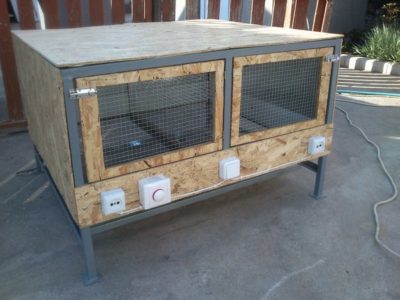

Newborn chickens are quite susceptible to the environment. Temperature fluctuations, changes in humidity, poor lighting, drafts are unacceptable for them. A brooder will help solve all these problems. Design features:
- Small size, length - meter, width and height - 0.5 meter.
- Made of dense material to provide thermal insulation. Should not get wet.
- A removable pallet is added to the structure, which is filled with a layer of sand. This will make it easier to change the layer contaminated with droppings.
- Feeders and drinkers are equipped in such a way that the chickens cannot turn them over or trample inside.
- Incandescent lamps of 40 or 60 watts are installed.
- The temperature regime is maintained at about 20-26 ° C.
With a brooder size of 100x50x50, the population can be up to 60 chicks.
Recycling of droppings
When properly maintained and properly fed, chicken droppings are rich in micronutrients. A large amount of it is a poisonous suspension. Processing poultry manure is an important task that needs the right solution.
The best option is to make compost. To do this, the manure is mixed with various plant wastes (residues of vegetables and fruits, foliage, weeds), straw, sawdust, peat, shavings. Fresh plants cannot be used for compost.
REFERENCE! Peat is used only if the compost will mature throughout the year, and it will have time to decompose.
Keeping chickens at home is not easy, but always beneficial. As a result, you will have not only food, but also excellent fertilizer for your garden.
Useful video
Watch the related video:
If you find an error, please select a piece of text and press Ctrl + Enter.
There are not so many people who want to keep a chicken in a city apartment, but such people still exist. The reason for this desire may be both the love for these healthy birds and the practical goal of constant access to fresh eggs and organic meat. But keeping chickens at home is not an easy task, which is accompanied by many restrictions and features, which we will consider in the article.

